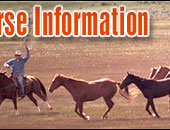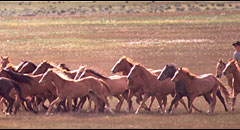 |
   |
|
|
|
You are here: Horses > Horse shoes / Hoof care > Equine winter hoof care |
Caring for Your Horse’s Hooves in the Winter
During winter you will most likely ride your horses less and
less, which makes it a perfect time to care for their
hooves. Probably the best way to begin winter hoof care is
to pull the horse’s shoes – depending on the terrain where
the horse is kept and the overall health of the hooves - to
give the hooves some time to thicken, to permit for heel
expansion, and to increase the circulation within the hoof
capsule. |
|
|
Keeping a horse without its shoes is often referred to as
“letting the horse go barefoot” and while this is a
desirable option in the winter, it also requires special
care for the animal’s hooves. For example, while you remove
some of the sole when applying shoes to the hooves, when the
horse goes barefoot, you will want to trim the hooves
differently. Do not remove the sole and leave more of the
hoof wall, which will be rasped by starting outside the
white line. The result will be a hoof with a surface that is
rounded and therefore protected from chipping, cracking and
other injury. |
Even though the hooves do not grow as quickly in the winter
as they do in the summer, it is still important to keep up
with regular hoof trimming, painting, and dressing. While
you may believe that allowing the horse to go barefoot in
the winter will decrease the care the hooves need, the
opposite is actually the case.
 In some cases you will not be able to allow your horse the
luxury of going barefoot. This may be the case if you are
expecting to still ride your horse during the winter. In
this situation you will need to take extra care to
accommodate the hooves to remain healthy during freezing
temperatures. You may choose to add pads under the horse’s
shoes, which eliminate the risk of sole bruises because of
the frozen ground. A snowball pad, which will avoid snow
packing under the hooves, will need to be used if you are
expecting a lot of snow. Some horse owners use flat plastic
pads sprayed with cooking oil, but the oils are known to
wear off rather quickly. More useful is the bubbly snow
pooper pad which simply prevents snow build up. Rim pads
made of rubber or more durable plastic dislodge any snow
build up. In some cases you will not be able to allow your horse the
luxury of going barefoot. This may be the case if you are
expecting to still ride your horse during the winter. In
this situation you will need to take extra care to
accommodate the hooves to remain healthy during freezing
temperatures. You may choose to add pads under the horse’s
shoes, which eliminate the risk of sole bruises because of
the frozen ground. A snowball pad, which will avoid snow
packing under the hooves, will need to be used if you are
expecting a lot of snow. Some horse owners use flat plastic
pads sprayed with cooking oil, but the oils are known to
wear off rather quickly. More useful is the bubbly snow
pooper pad which simply prevents snow build up. Rim pads
made of rubber or more durable plastic dislodge any snow
build up.
If your area is susceptible to ice and snow, the shoes
should be changed to permit for the wearing of shoes with a
crease, and substances that assure added traction to prevent
slipping and subsequent injury.
There are different options with respect to offering added
traction to your horse via the shoes. You may consider using
borium, which is a resilient surfacing material. Application
of this substance to the shoe needs to be done sparingly in
the heel, avoiding large portions on the bottom of the shoe
which will only stress the hoof unnecessarily. Another
option to offer traction to your horse’s hooves is to use
studs or ice nails. Studs may be driven in on a permanent
basis, while screw-ins will provide temporary traction. Ice
nails simply replace the already present heel nails, and a
borium bubble on the head of the nail provides the traction.
This latter option is probably the least functional.
It is usually suggested that horse owners stay away from
snowshoes for horses simply because the build up of snow
underneath the foot is a health hazard to both horse and
rider. Add to this the fact that thin-soled horses may quite
possibly experience adverse reactions to these shoes such as
bruising, and you will understand why it is probably best to
not to choose this option.

|
Read the next horse shoes article on
Hoove balence Hooves through Angle. |
|
|
|
|
 |
|
|
|
|
|
Horse Education
|
|
|
|
|
Horse Information Topics
|
|
|
|
|
|
|
|
Horse Business Owners
|
| |
Advertise with Us
Have your horse products or services exposed to over 27,000 of our monthly visitors.
|
|
|
|
|
|